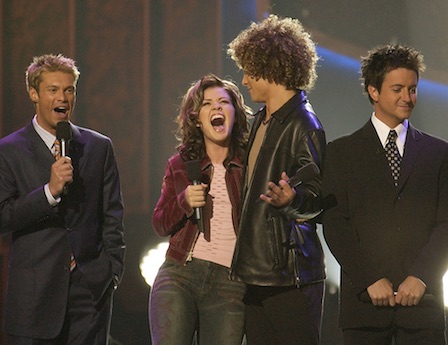‘Idol’ Less Vital, But Still an American TV Titan

How can we not take a moment to salute American Idol, tarnished as that Idol may be, as it signs off Thursday night? While the show has hardly been a ratings magnet or pop culture touchstone the last five years, it averaged at least 20 million viewers per episode for close to a decade, and that’s not nothing.
Debuting in 2002, American Idol of course came from a different era—before YouTube and Facebook and the cavalcade of compelling originals on cable (FX’s pioneering The Shield too debuted in 2002), much less on Netflix and Amazon and Hulu. It’s mighty hard to picture another show averaging 30 million viewers, as Idol did in seasons five and six (live-plus-seven), ever again.
“You never say never, and circumstances constantly change,” said Bill Carroll, Katz Television Group senior VP/director of content strategy. “But the likelihood of there being such a dominant program on a consistent basis, given the competition and fragmentation, is unlikely. It was a different place and a different time.”
Back when the show was the “summer’s sleeper hit,” according to the New York Times, a reporter compared splenetic Simon Cowell to Anne Robinson, host of The Weakest Link. “I resent that,” said Cowell. “She’s a 65-year old woman with a really boring show. Our show is fun.” (Yes, Idol debuted in the summer. It also had a co-host alongside Ryan Seacrest. Remember Brian Dunkleman?)
Idol was fun, and at times still is. Who can forget William Hung and “She Bangs”, that peculiar man who sang “Pants on the Ground”, and whatever your favorite Cowell put-down was? (“You sound like Dolly Parton on helium” may fit the bill for many.)
The two-hour series finale features La’Porsha Renae and Trent Harmon, both of Mississippi, vying for the final prize. (Last night, before pop-punkster Dalton Rapattoni was voted off, the usually solid Seacrest noted the “irony” of all three finalists auditioning in Little Rock. It wasn’t a wee bit ironic, but it was pretty coincidental.) Last night’s show did a 2.2 in adults 18-49, according to Nielsen’s overnights, up 5% from the previous new episode.
The first season averaged a 6.2 live rating and 18 share in adults 18-49, according to Nielsen numbers provided by Fox, with an average of 12.6 million viewers. Season two grew to a 10.2/26, with 21.7 million total viewers, and up it went. Rival programmers dubbed American Idol the Death Star; it was, indeed, where competing shows went to die.
The smarter way to stay on top of broadcasting and cable industry. Sign up below
Idol’s ratings have trended downward since 2006’s high water mark of 30.7 million viewers in live-plus-seven, but as recently as 2012 it still drew an average of close to 20 million.
This year it’s more like 11 million, and we’ll see how Idol rates tonight. “I’d be very surprised if the finale doesn’t generate significant audience,” says Carroll.
There were missteps across those 15 seasons, but not that many. Ellen DeGeneres was hopelessly miscast as a judge, while the feuding between jurists Mariah Carey and Nicki Minaj got old fast, and took attention away from the performers.
The current judges, Keith Urban, Jennifer Lopez and Harry Connick Jr., appear to get along fabulously. They’re appealing to look at and offer meaningful critiques that show off their hard-won musical chops, and—unlike Cowell--rarely reduce a performer to tears.
Cowell departed the judges’ table after the 2010 season. Fox had massive plans for another Cowell-helmed British import, X-Factor, which debuted in the fall of 2011. Months before that, B&C’s then editor, Ben Grossman, wrote, “I have seen the future of American Idol, and it is called X-Factor.”
Cowell said it would beat Idol. Yet X-Factor never lived up to those expectations; the future of AmericanIdol was diminished ratings, not a comparable successor. X debuted to a 4.2 rating in 18-49, around half of Idol’s average score at the time. Cowell backtracked on his prediction. After three seasons, X-Factor was done.
U.S. viewers will get more of Cowell this summer, as he’s on board to be a judge on America’s Got Talent on NBC for season 11. That starts May 31.
So what is American Idol’s legacy? Besides paving the way for performance shows such as NBC’s The Voice, it catapulted the likes of Kelly Clarkson, Katherine McPhee, Carrie Underwood and Chris Daughtry onto the pop culture landscape—music and television. It got people used to buying things on iTunes, and if Tuesday’s retrospective program is to be believed, taught much of America how to “text message”, in the patois of the era.
Foremost, American Idol showed that broadcast TV could still gather a giant crowd without a Super Bowl, Emmy or Oscar being contested.
“It was, and will continue to be, a certain benchmark when we look back at the history of broadcast television,” says Katz’s Carroll. “I don’t think that will ever change.”
Michael Malone is content director at B+C and Multichannel News. He joined B+C in 2005 and has covered network programming, including entertainment, news and sports on broadcast, cable and streaming; and local broadcast television, including writing the "Local News Close-Up" market profiles. He also hosted the podcasts "Busted Pilot" and "Series Business." His journalism has also appeared in The New York Times, The L.A. Times, The Boston Globe and New York magazine.

